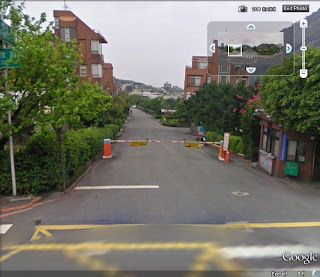When the Japanese occupied Taiwan from 1895-1945, they built many resorts for their leisure. And they built the hostel in Yangmingshan to last.
During the American presence it was called the Grass Mountain Hostel. Either way, imagine the many thousands who have used it over the centuries.
During the American presence it was called the Grass Mountain Hostel. Either way, imagine the many thousands who have used it over the centuries.
The whole complex now has nothing to do with being a place to live and sleep for travelers and service people.
According to the literature, since 1981, it has been known as the Taipei Teachers' In-Service Education Center. It's considered to be in the Beitou (Pei Tou) District of Taipei although it's just off YangMing Road.
According to the literature, since 1981, it has been known as the Taipei Teachers' In-Service Education Center. It's considered to be in the Beitou (Pei Tou) District of Taipei although it's just off YangMing Road.
There are many people who, through their pictures and individual efforts, have made this post possible. My contribution was to assemble these people's bodies of work and put them in some semblance of order.
The first person to thank is fellow blogger, Don Wiggins of ustdc.blogspot. If he hadn't posted references to the hostel in May 12, 2008 and July 18, 2008, that would have been it. Stev Pitchford is the first person to post photos in 2008.
His permission to use them was crucial. Then, Victor W. Cheng is to thank for contacting Miss Liangcw to gain permission to use her photos from her blog. Of course, a big thanks goes to Miss Liang for taking and posting her pictures. And then, there's Andy Savin, my friend.
With that, then, here is the Grass Mountain Hostel as it was then and now.
 |
To give some reference to the site, I chose DaHeng Road where our apartment was. About .25 miles north of it, the district and road name change. It's still a steep climb.
|
 |
| Continuing through the village, we are almost there. |
 |
| Here is the entrance to the education center. |
 |
| Photo courtesy of liangcw/blog This statue stands just outside the entrance. |
 |
| Photo courtesy of liangcw/blog The entrance was not this inviting in 1968. |
 |
| Photo courtesy of liangcw/blog Moss often adds character. |
 |
| Photo courtesy of liangcw/blog The windows, eaves, soffit and fascia are well preserved. |
 |
| Photo courtesy of Stev Pitchford Here is the hostel in 1959 from another angle. |
 |
This photo is from the Yangmingshan National Park collection. Hopefully this reference link will do. I tried to e-mail them to get permission to use this picture, but was unable to submit my request.
Since It is so similar to the previous picture the hope is that YMSNP will approve of its use on this blog. Otherwise, this picture will come down. |
 |
With a large parking lot in front it, the old hostel can be plainly seen. Surrounded by large complex, the building is just part of of a sizable teacher education center.
|

































